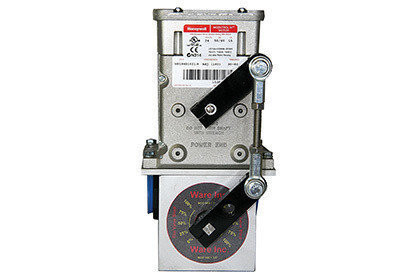Modulating Feed Water Valves
Modulating Feedwater valves allow for constant incremental adjustments to feed water into your boiler. They come in all types from ball valves, to knife gates, to globe valves and operate off of many types of signals. Some typical applications are 0-135 ohm slide wires from a McDonnell and Miller 7b switch or a 4-20ma signal from a differential pressure transmitter.
They can be electric or pneumatic also. We can provide many types and we even manufacture our own brand in the WARE Mod-V. Contact us and we'd be happy to size and select the proper valve for your application.
If you do not see the part you want below, feel free to use the chat function and see if we possibly have the part you are looking for in stock.

Modulating Feed Water Valves Categories
What are Modulating Feed Water Valves & what is their function?
Modulating feed water valves supply feedwater with precision
As boilers turn water into steam, the volume of condensed water inside the boiler changes. In order to keep the boiler running at full efficiency, additional feedwater must be added from time to time. Modulating feedwater valves do that with greater precision, allowing the boiler to maintain peak efficiency.
Modulating feed water valves adjust the flow as needed
Some valves operate like a light switch, meaning they’re either all the way on or all the way off. Modulating feedwater valves operate like dimmer switches. Since they open and close in small, precise movements, they allow precision adjustment of the flow of feedwater to the boiler.
Different Types of Modulating Feed Water Valves & How To Choose
They are offered in two main types.
Full Port Valves
Offer greater flow, but less precision in flow control. They are most often used in deaerator cold water inlets.
V-Port Valves
Offer less overall flow, but greater precision. When properly sized, they can supply the exact amount of water the boiler is using, creating a cycle of optimal efficiency and performance.
THE WARE MOD-V VALVE
WARE manufactures its own brand of modulating feedwater valve, the MOD-V. It’s a V-port valve designed with all of the features that we think the right valve should have, based on our decades of boiler experience. It’s precise, leakproof, and built to last.
The Role Modulating Feed Water Valves Play in a Boiler
No matter how much you preheat it, adding a sudden large quantity of feedwater to a boiler will temporarily reduce the water temperature inside, which costs steam production. By introducing small amounts of feedwater gradually over time, a modulating feedwater valve helps maintain proper water levels without sacrificing performance.
what are the Effects of a Bad Modulating Feed Water Valve?
If a modulating feedwater valve is starting to fail, it may not open or close as needed. This will cause a loss of boiler efficiency and could create a safety hazard if the water level falls too low.
Things to Consider about modulating feed Water Valves:
- Modulating feedwater valves work best when connected to an automated boiler control system with modulating motors.
- By working together, they create a feedback loop that allows the boiler to fine-tune its feedwater supply for maximum efficiency and output.
Helpful Resources
Relevant WARE Videos on Modulating Feed Water Valves
Getting Control of your Feed Water with the WARE Mod-V
Precision Feed Water Valve for Your Steam System
Common Problem fix for Boiler Feedwater Valves
Utilizing Variable Speed Drives on a Deaerator
McDonnell Miller 7 B Switch | Different Types of Level Controls
What is Carryover and the Factors That Cause It
What Does a Steam System Feed Water Deaerator Do?
What are the differences between a Gate Valve and a Globe Valve
Explore over 750+ explanatory videos on boilers and boiler systems on our Youtube channel. Our videos can help you quickly grasp complex boiler topics. Watch more here!
Relevant WARE Blog Articles on Modulating Feed Water Valves
Modulating Feedwater Valves: The Method Behind the Movement
How to Maintain the Strainers on a Feed Water System
What Are the Differences Between a Gate Valve and a Globe Valve?
Our informative and educational blog content can help you gain a deeper understanding of the boiler room. Read more here!
Technical Documents
Modulating Feed Water Valves FAQ
How does linkage affect my valve’s performance?
The linkage is the connection between the valve and the motor that controls or actuates it. If that linkage becomes too slack or too tight, the valve will not be calibrated to the motor properly, which can cause incorrect flow rates.
What’s the difference between a modulating feedwater valve and a pump?
Because a boiler operates under pressure, water must be introduced to the boiler under pressure. The pumps maintain that pressure, while the modulating feedwater valves adjust the amount of water that is let into the boiler itself.
Does my feedwater need to be treated?
Absolutely. Before it passes through a modulating valve into the boiler, the feedwater needs to be properly softened and treated with chemicals that reduce oxygen and keep solids in suspension. Improperly treated water is the number one cause of corrosion and reduces boiler life.
What types of valves do modulating feedwater valves use?
Ball Valves use a metal ball in a housing that rotates on its vertical axis to expose or cover a hole in the ball through which water can pass.
Gate Valves use a metal gate that travels up and down to adjust flow.
Globe Valves use a metal globe or disk that presses into a seat to increase or decrease flow.


